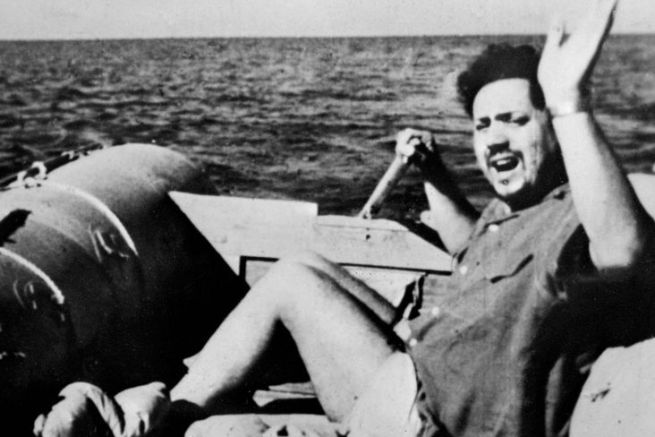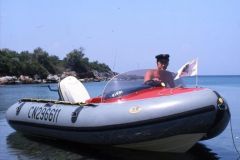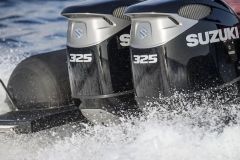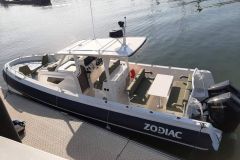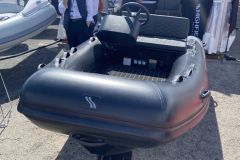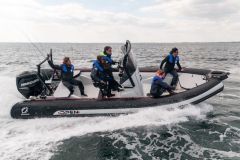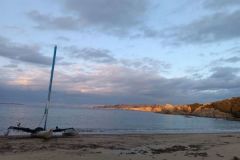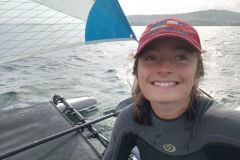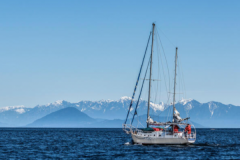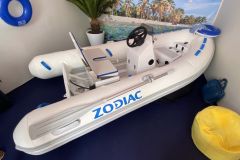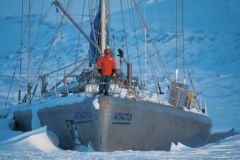The heretic, a Zodiac that bears his name well
Sunday, October 19, 1952, Gran Canaria Island, Las Palmas Port, 06:00 in the morning, a lonely man, aboard a Zodiac tire called "The Heretic", 4.65 m long, rigged with an Optimist sail, moves away in the dim light of the silent dawn and the lapping of his oars towards the west... After a few hours of rowing, once the islands out of sight, the man stows his oars on board and lies down on board his skiff, calm and alone..
On board, no water, no food, neither fresh nor canned, just a man on his makeshift, open boat, with a tent, a sextant, a fishing line, a knife, a plankton net and a few baubles. The man lets his boat drift, because that is his project: he will let himself drift, try to cross the Atlantic, like a volunteer shipwrecked person..
This man is Alain Bombard, a 30-year-old medical doctor, determined to show the world that it is possible to survive at sea without food.
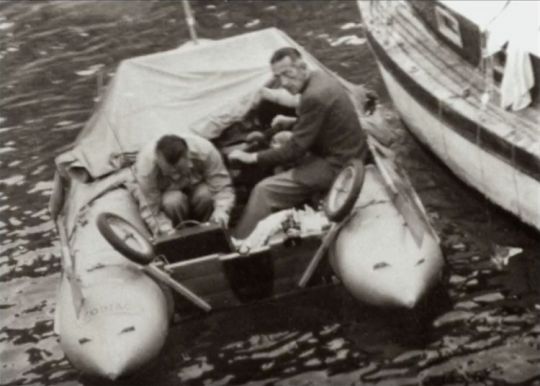
The sinking of the Notre Dame de Peyragudes
Already the previous year, he had crossed the sleeve in a swimsuit simply coated with grease to limit heat loss, and had drifted, already on a Zodiac in engine failure, three whole days. During this time, he had lived off Boulogne-sur-Mer on a butter tablet and a little seawater.
In Boulogne-sur-Mer, where he was doing his medical internship, he reportedly witnessed the arrival at the morgue of the 41 crew members of the "Notre-Dame de Peyragudes", a trawler that sank offshore in a few minutes (maritime archives report 10 drowned and 6 survivors...).
Thanks to a scholarship offered by a wealthy patron, he obtained a research position in Monaco where he developed a theory on survival at sea. This theory is inspired by the view of the bodies of the men of the Our Lady of Peyragudes. Robust sailors, in the prime of their lives, able to swim, but nevertheless drowned.
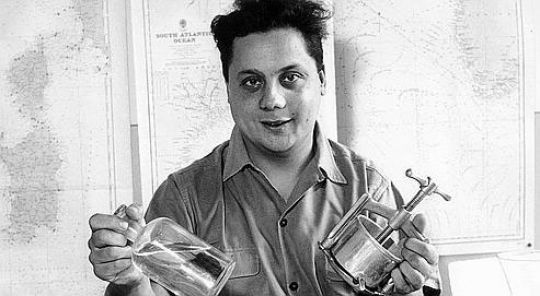
Bombard's theory of survival at sea.
His starting point is that the shipwrecked, deeply affected by the events and the total certainty that they will not be able to survive, let themselves die of despair, their morale wiped out. He developed a theory on feeding and hydration at sea that he believed would allow a large number of shipwrecked people to survive.
He says that survival at sea is possible, drinking rainwater, a little seawater and fish juice, eating raw fish and filtered plankton (a source of vitamin C to fight scurvy). He insists on the importance of keeping busy so as not to sink into despair and on the dangers of big fish for my small tyres.
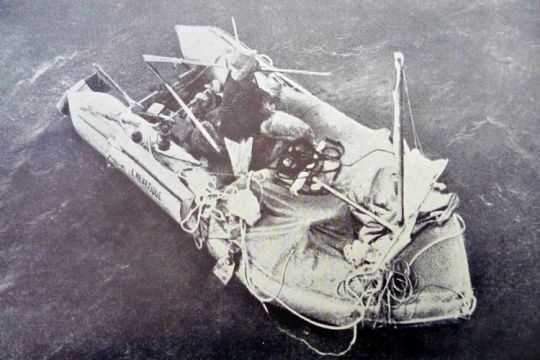
An expedition to prove his theory
Determined to prove the effectiveness of his theory, he undertook a long journey across the Mediterranean and then the Atlantic, leaving Monaco on May 25, 1952, accompanied initially by Jack Palmer, a British sailor.
The first stopover takes them to the Balearics after 18 days at sea. Tired, along the way, the two shipwrecked men were rescued and supplied by a cargo ship. Palmer abandons the project. Bombard continues alone to Las Palmas, via Tangier and then Casablanca.
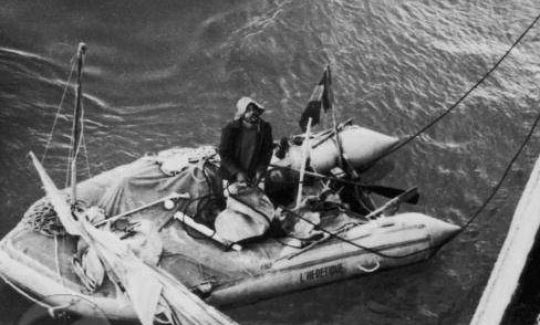
A crossing without food, under makeshift rigging, alone
After leaving Las Palmas (Canary Islands), Bombard didn't see any rain for 22 days! It feeds on plankton from which it filters with a personal invention and drinks fish juice which it presses with a rudimentary press.
He has no idea where he finds it, his practice of esteem being recent!
But he doesn't harvest a pint of fresh water for three weeks. Caught in anguish, Bombard wrote his will on board on December 6. His morale seems to be at its lowest. He loses weight and weakens. The fishing is average and he only consumes raw fish and plankton, whose fish tastes and smells disgust him to the point of discomfort.
He suffers from bad weather, including a storm during which, having lost his bucket, he is hit with his shoe and hat!
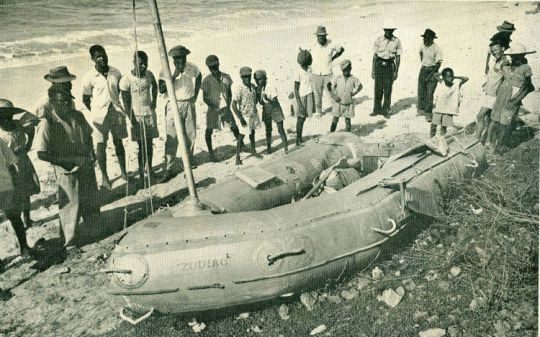
The meeting with a cargo ship and the Lindemann controversy
Halfway across the Atlantic, he crossed paths with the bulk carrier Arakaka, whose crew convinced him to board for a meal. He accepts a frugal lunch and becomes aware of his error of esteem, taking him 600 miles away from his objective. Despite the warnings of the Arraka's commander, relying on his unfailing determination, he set sail again, alone at sea.
There has been a serious controversy about this meeting at sea since Hannes Lindemann published photographs in the 1950s. This competing "adventurer" also, a little later, crossed the Atlantic by kayak with some food. The photographs in question showed Bombard loading food from the cargo ship, which he had always denied. Bombard would also have carried a sealed "ultimate reserve of water and food" that he would not have consumed, even if it had happened in Barbados...
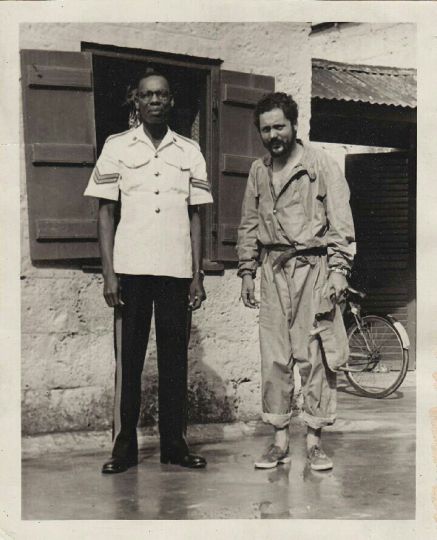
Arrival in Barbados
Drifting westward, he advances painfully at the speed of a knot, crushed by the sun, perplexed by pain, hallucinated, hungry and thirsty, crossing with sharks, dolphins and other cetaceans as travelling companions of his frail skiff...
He finally arrived in Barbados on 23 December 1952, after 113 days at sea! But he is in a critical physical condition requiring long hospitalization and later kidney removal. He returned to Paris and published "Naufragé Volontaire" in 1953, which was a worldwide success and laid the foundations for the survival techniques still in use today.
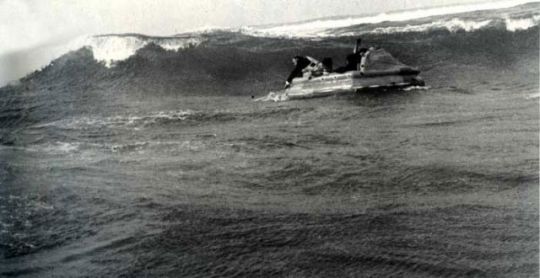
The drama of the Etel Bar canoe
He then collaborated with a manufacturer of rubber boats, the Angevinière, which would be known as Bombard in 1972. It is with these inflatable boats that he tries to cross difficult passages to show their marine capability and effectiveness as a lifeboat.
On October 3, 1958, in heavy weather, he tried to cross the "Barre d'Etel", a large dangerous blade on a high tide day. The crew is composed of Alain Bombard and 6 sailors from Etelois. Around 11am, it was a tragedy, the 7 occupants fell into the sea and the local lifeboat, which also suffered damage, capsized.
Operation report: 9 sailors drowned. An investigation cleared Bombard of all responsibility, but the case had significant media coverage.
Bombard came out of this tragedy and its media exposure very affected and entered a long period of depression that culminated in 1963 in a suicide attempt..
He then collaborated with Paul Ricard at his oceanographic institute, before becoming involved in politics in the field of ecology and sea protection, and finally as Secretary of State in the Pierre Mauroy government.
A finally controversial career
Despite the controversies that have marked his career, it is difficult to lose sight of the fact that Bombard crossed the Atlantic alone on what we would now call an annex, with little or no food or assistance of any kind, and thus demonstrated to everyone that hope can remain, even for a lonely shipwreck!
He died in Toulon, at the age of 80 on July 19, 2005.
